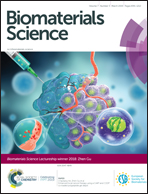A NIR-II fluorescent probe for articular cartilage degeneration imaging and osteoarthritis detection†
Abstract
Articular cartilage (AC) is a complex water-bearing tissue consisting of chondrocytes, proteoglycans, and collagen. AC degeneration, which occurs in the early stage and throughout the entire course of osteoarthritis (OA), is one of the main pathological changes of OA. However, current clinical approaches are unable to detect AC degradation during the early stage of OA. Herein, a novel NIR-II probe, CH1055-WL, was developed with an organic fluorophore (CH1055) and type II collagen-binding peptide (WYRGRL) for AC targeting and degeneration imaging. In vitro and in vivo imaging studies demonstrated that CH1055-WL specifically bound to AC and permitted sensitive detection of age-related or surgically induced AC degeneration in living mice. In vitro imaging of cartilage samples from pig knee joint and in vivo imaging of live mice with the probe administered via local injection in joint cavities demonstrated that CH1055-WL specifically and efficiently bound to AC. Further evaluation of CH1055-WL revealed sensitive detection of age-related AC degeneration and surgically induced AC degeneration in living mice. Our results indicated that the cartilage-targeting probe CH1055-WL allowed visual monitoring of AC degeneration in living subjects, thus displaying promise for early OA detection.



 Please wait while we load your content...
Please wait while we load your content...